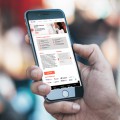Building Healthcare App Development with S3Corp: Key Considerations and Steps
— June 10, 2020In today’s globalized world, industries—especially healthcare—are racing to leverage advancements in technology. The healthcare landscape has undergone a paradigm shift with the integration of digital solutions. As traditional websites evolve into comprehensive apps, healthcare organizations increasingly use technology to enhance patient experience and streamline operations. Building healthcare apps—innovative tools that provide personalized medical care, expert advice, and essential health resources at the touch of a screen.
With S3Corp’s commitment to excellence in software development, let’s explore the essential steps and considerations for creating a successful healthcare app that serves patients, doctors, and healthcare providers alike.
Understanding the Impact of Healthcare Apps
Healthcare apps are not merely about convenience; they represent a transformation in how medical services are accessed and delivered. These apps enable patients to:
- Obtain expert advice within seconds.
- Book appointments and purchase medical products and services.
- Monitor their health and communicate smoothly with their doctors.
However, developing a healthcare app that is genuinely impactful and user-centric requires careful planning and precise execution. The following six guidelines detail the crucial steps involved in creating an app that meets user needs and industry standards.
1. Define Your Target Audience
To create a successful healthcare app, it’s essential to design it with a clear understanding of the intended audience. Just as healthcare organizations serve specific communities, healthcare apps must cater to the unique needs of their target users—be they patients, healthcare providers, or caregivers.
To define and understand your audience:
- Identify Needs and Pain Points: Begin by identifying the challenges your target users face. Are they looking for on-demand consultations, medication management, or health tracking?
- Conduct User Surveys and Research: Surveys, focus groups, and direct feedback from potential users can provide valuable insights into desired features and usability preferences.
- Implement Customizable Features: Based on the collected data, integrate features that enhance user experience and broaden accessibility, such as voice commands, easy navigation, and multilingual options.
2. Leverage Advanced Software Solutions
Software innovation is at the heart of healthcare modernization. From wearable devices and diagnostic tools to pharmaceutical advancements, harnessing advanced software solutions can significantly improve app functionality and user experience.
Integrate Advanced Functionalities:
- Telemedicine Capabilities: Enable users to schedule virtual consultations, securely communicate with healthcare professionals, and access medical advice instantly.
- Secure Health Records Access: Ensure users can securely store and share their health records within the app, complying with HIPAA or other applicable data privacy laws.
- AI-driven Predictive Analytics: Incorporate AI to provide predictive insights, helping users stay informed about potential health issues and manage chronic conditions effectively.
By integrating cutting-edge software, you create a robust, functional, and reliable tool for users.
3. Foster Collaboration and Clear Communication
App development is a collaborative process that requires skilled team members and clear communication at all stages. Misalignment within the development team can lead to significant setbacks, compromising both budget and timeline.
Strategies for Effective Team Coordination:
- Establish Clear Roles and Responsibilities: Clearly define roles early in the process. Assign developers, designers, QA testers, and marketing strategists specific responsibilities to promote accountability.
- Schedule Frequent Check-ins and Milestones: Regular meetings will ensure the team remains aligned on priorities and can address challenges as they arise.
- Maintain a Unified Vision: From design concepts to development stages, every team member should understand the project’s goals and audience needs to make informed decisions.
A cohesive and well-coordinated team is more likely to develop a successful, user-friendly app.
4. Assess the Development Costs
Creating a healthcare app can be a costly venture. Costs can quickly escalate due to software requirements, data storage, security measures, and integration with other platforms. Therefore, establishing a detailed budget based on anticipated needs and features is crucial.
Financial Planning Tips
- Prioritize Key Features: Concentrate on essential functionalities that address users’ pain points. Non-essential features can be integrated in later updates.
- Consider Long-term Costs: In addition to initial development expenses, ongoing maintenance, user support, and feature upgrades can significantly impact the budget.
- Secure Funding: Healthcare organizations may seek partnerships, grants, or investors to help offset development costs, especially if the app aims to serve a wider community.
By planning thoroughly, you can ensure that financial resources are allocated wisely without compromising quality.
5. Differentiate Your App from the Competition
The healthcare app market is saturated with applications offering similar functionalities. To gain traction, your app needs to stand out in both design and functionality, providing unique value that users cannot find elsewhere.
Strategies to Stand Out:
- Conduct Market Research: Analyze existing healthcare apps to identify their strengths and weaknesses. Review user feedback to pinpoint common complaints and gaps in service.
- Introduce Unique Features: Consider adding innovative functionalities, such as personalized health recommendations, mental health resources, or integration with popular wearables like Fitbit or Apple Watch.
- Focus on User Experience (UX): A smooth, intuitive interface can significantly enhance user satisfaction. Simplify navigation, ensure a clean design, and prioritize user accessibility.
Creating an app that provides distinct value and is easy to use will help establish a competitive edge in a crowded market.
6. Implement a Thorough Testing Process
Testing is a crucial step in healthcare app development, as it helps uncover potential issues before public release. Conducting comprehensive testing allows you to refine the app’s functionality, usability, and reliability to meet user expectations.
Key Testing Phases:
- User Acceptance Testing (UAT): Involve real users to test the app under normal conditions. Their feedback is vital for making final adjustments regarding usability and performance.
- Security Testing: Given the sensitivity of medical data, your app must comply with stringent security protocols. Test for data encryption, secure storage, and adherence to regulations like GDPR and HIPAA.
- Performance and Load Testing: Ensure the app runs smoothly during peak usage times. Identify and resolve any latency issues to avoid disruptions for users.
Thorough testing not only identifies potential issues but also enhances the app’s credibility and reliability, contributing to higher user satisfaction upon release.
Conclusion: Elevating Healthcare with User-Centric Apps
As healthcare continues to evolve, mobile apps are becoming essential in improving patient care, connecting providers, and enhancing health management overall. A well-designed healthcare app can revolutionize the interaction between patients and providers, streamline processes, and deliver care more effectively.
Developing a healthcare app requires strategic planning, a well-coordinated team, thorough testing, and a commitment to creating a user-centric solution. By carefully considering the target audience, leveraging advanced software, fostering teamwork, budgeting wisely, and focusing on testing, healthcare organizations can build apps that truly make a difference.
With S3Corp’s expertise in healthcare app development, our mission is to help healthcare providers transform their digital presence, ultimately enhancing patient satisfaction and achieving operational excellence. Whether it involves delivering telemedicine solutions or integrating with existing healthcare systems, we are here to support every step of the way.








